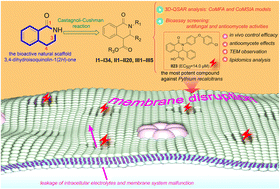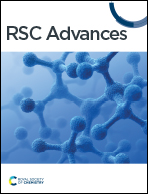Synthesis of 3,4-dihydroisoquinolin-1(2H)-one derivatives and their antioomycete activity against the phytopathogen Pythium recalcitrans†
Abstract
In an effort to exploit the bioactive natural scaffold 3,4-dihydroisoquinolin-1(2H)-one for plant disease management, 59 derivatives of this scaffold were synthesized using the Castagnoli–Cushman reaction. The results of bioassay indicated that their antioomycete activity against Pythium recalcitrans was superior to the antifungal activity against the other 6 phytopathogens. Compound I23 showed the highest in vitro potency against P. recalcitrans with an EC50 value of 14 μM, which was higher than that of the commercial hymexazol (37.7 μM). Moreover, I23 exhibited in vivo preventive efficacy of 75.4% at the dose of 2.0 mg/pot, which did not show significant differences compared with those of hymexazol treatments (63.9%). When the dose was 5.0 mg per pot, I23 achieved a preventive efficacy of 96.5%. The results of the physiological and biochemical analysis, the ultrastructural observation and lipidomics analysis suggested that the mode of action of I23 might be the disruption of the biological membrane systems of P. recalcitrans. In addition, the established CoMFA and CoMSIA models with reasonable statistics in the three-dimensional quantitative structure–activity relationship (3D-QSAR) study revealed the necessity of the C4-carboxyl group and other structural requirements for activity. Overall, the above results would help us to better understand the mode of action and the SAR of these derivatives, and provide crucial information for further design and development of more potent 3,4-dihydroisoquinolin-1(2H)-one derivatives as antioomycete agents against P. recalcitrans.



 Please wait while we load your content...
Please wait while we load your content...